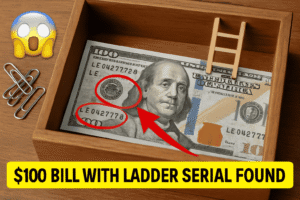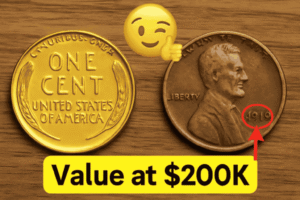Imagine this: You’re rummaging through an old jar of coins in your grandma’s kitchen. Pennies, nickels, the odd Canadian dime (where did that come from?)—and suddenly, there it is. Brownish-red, a little worn, but something about it feels different. You flip it over. “1943.” You think, Cool, old coin. What you don’t realize? You might be holding a multi-million dollar mistake.
Yeah, we’re talking about that penny. The 1943 copper Lincoln Wheat Penny. One of the rarest coins in U.S. history—so rare, one just sold for a jaw-dropping $4.4 million.
Let’s dig into how a humble cent turned into a collector’s Holy Grail.
Wartime Metal Switcheroo: Why 1943 Was a Weird Year for Pennies
Here’s the backdrop: It’s 1943. America is neck-deep in World War II. Copper—essential for bullets, shell casings, and wiring—is in critically short supply. So, the U.S. Mint pulls a bold move: swap the copper in pennies for steel coated in zinc.
Steel pennies. They looked silver, they rusted easily, and people weren’t thrilled. But hey, it was wartime. Everyone was sacrificing something—even their beloved copper coins.
But here’s where it gets interesting.
By sheer accident, a few copper blanks—leftover from 1942—got stuck in the presses. They were never supposed to be used, but some slipped through the cracks and were minted into 1943 pennies. These copper outliers are now one of the most famous minting errors in American numismatic history.
Rarer Than Rare: How Many Exist?
The short answer? No one knows for sure.
Estimates suggest fewer than 20 genuine 1943 copper Lincoln cents exist today. Some say maybe a couple dozen. That’s it.
The U.S. Mint never intended to release them, and they didn’t publicly acknowledge the mistake until collectors started discovering these oddities. Over the years, a few have popped up—mostly from folks who had no idea what they were holding. One kid reportedly found his in the ’40s and just held onto it. Decades later? Boom. Multi-million-dollar payday.
The $4.4 Million Penny: A Teen’s Lucky Break
Let’s talk about the penny.
It was discovered by a teenager back in the late 1940s—decades before coin collecting went digital or coins had QR codes or whatever madness we’re heading toward. This kid, probably just happy to find an old coin, tucked it away.
Years later, a professional had it tested. Not a fake. Not a joke. Real copper. Real 1943. Real jackpot.
And in 2024, that very penny sold for $4.4 million. Not a typo. Four-point-four-million-dollars. For one penny.
That’s more than a brownstone in Brooklyn. That’s a down payment on a private island. That’s—well, you get the picture.
How to Tell If You’ve Got One (Without Losing Your Mind)
Before you start turning your house upside-down, here’s how to spot a potential 1943 copper penny:
| Test | What to Look For |
|---|---|
| Year | 1943 (duh) |
| Material | Copper has a reddish hue. Steel looks silver-ish. |
| Magnet Test | Steel pennies stick to magnets. Copper ones won’t. |
| Weight | Copper pennies weigh about 3.11 grams. Steel ones? Closer to 2.7g. A good digital scale helps. |
| Mint Mark | Look for “D” (Denver) or “S” (San Francisco). Most found have no mark (Philadelphia). |
Important: Fakes exist. Some people try to file down the “8” in 1948 to look like a “3”. If you think you’ve got the real deal, do not clean it and take it to a certified coin expert. Immediately.
Is It Likely You’ll Find One?
Honestly? Not really. It’s like finding a first-edition Harry Potter at a garage sale or the original Apple I computer in a closet. Possible—but rare.
Still, stranger things have happened. Some of these coins were found in pocket change, old jars, even hidden in junk drawers. So yeah—it’s worth checking.
Plus, going through old coins is oddly relaxing. Meditative, even. Just you, some rusty cents, and the quiet hope of life-changing treasure.
Should You Save Old Pennies Anyway?
Absolutely. Especially:
- Pre-1960 pennies (many are solid copper and worth more than face value)
- Wheat pennies (minted 1909–1958; collector interest remains high)
- Error coins (off-center strikes, double dies, etc.)
Most won’t buy you a Ferrari, but some are worth a few bucks. And hey, it’s fun.
FAQs
Why is the 1943 copper penny so valuable?
It was a mistake. A tiny fluke in the minting process during wartime. Rarity + historical context = serious collector gold.
How can I test my 1943 penny?
Start with a magnet. Steel pennies stick; copper ones don’t. Then, check the weight. But to be 100% sure, get it authenticated by a pro.
Can I still find one?
It’s possible, but don’t bet the farm. Still, coin roll hunting and checking old jars is a harmless (and potentially lucrative) hobby.
Are other old pennies valuable?
Yep. Especially ones with mint errors, low mintages, or those made of pure copper (pre-1982 pennies weigh more and are 95% copper).
Should I clean an old coin before selling?
No. Never. Don’t even think about it. Cleaning can kill the value.



